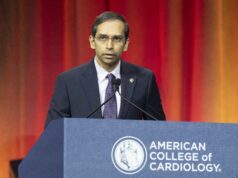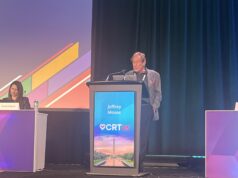
The initial results of the first randomised controlled trial—PRAGUE 18—to directly compare prasugrel (Efient, Daiichi Sankyo) with ticagrelor (Brilinta, AstraZeneca) indicate there are no significant differences in outcomes between the drugs when they are used to treat patients with acute myocardial infarction who have undergone percutaneous coronary intervention (PCI). However, the study was terminated early because of futility and, therefore, was underpowered.
Writing in Circulation, Zuzana Motovska (Cardiocentre, Third Faculty of Medicine, Charles University and University Hospital Kralovske Vinohrady, Prague, Czech Republic) and others state that the class and level of guidelines recommendations for prasugrel and ticagrelor—both more potent PY12 inhibitors than clopidogrel—are identical but add that the reported use of these drugs in clinical practice “suggests that physicians do not view these agents as interchangeable and tend to favour one, over the other, for respective patients”. Furthermore, there have been no randomised comparisons of prasgurel vs. ticagrelor, the authors comment, “since the higher efficacy of these newer PY12 inhibitors were first demonstrated relative to clopidogrel”.
Therefore in this randomised, multicentre trial, they aimed to compare the efficacy and safety of prasugrel and ticagrelor in acute myocardial infarction patients who had undergone primary PCI. The primary endpoint was a composite of all-cause death, re-infarction, stroke, serious bleeding requiring transfusion or prolonging hospitalisation, or urgent target vessel revascularisation within seven days after randomisation or at discharge if prior to the seventh day. A secondary efficacy endpoint was a composite of cardiovascular death, non-fatal myocardial infarction, or stroke during the follow-up period.
The power analysis was computed for a primary endpoint difference of 2.5%, a two-sided overall alpha level of 0.5 and statistical power of 80%. Motovska et al report that the needed sample size was estimated at 1,250 patients in each arm. However, they add that an interim analysis of the first 1,130 patients led to a decision to terminate the study early due to futility. Therefore, only 1,230 patients—rather than the planned 2,500—were enrolled in the study. Of these, 634 were randomised to receive prasugrel and 596 were randomised to receive ticagrelor.
“The occurrence of the primary endpoint did not significantly differ between groups receiving prasugrel and ticagrelor (4% and 4.1%, respectively; p=0.939). Furthermore, no significant difference was found in any of the components of the primary endpoint,” the authors state. They add that there were also no significant differences in the rate of the key secondary endpoints between groups.
While noting that the study was “underpowered” to make the “final conclusion regarding a direct comparison of efficacy and safety of prasugrel and ticagrelor”, Motovska et al write that the identified differences in the occurrence of a primary endpoint between compared groups “were very low in absolute numbers and clinically irrelevant”. Furthermore, the difference in the primary endpoint was consistently low and stabilised with a growing number of patients. “This head-to-head comparison of prasugrel and ticagrelor, based on a small number of patients and events, does not support the hypothesis one is more effective or safer than the other in preventing ischaemic or bleeding events in the acute phase myocardial infarction treated with primary or immediate PCI,” they conclude.
However, speaking at the 2016 European Society of Cardiology (ESC) congress (27–31 August, Rome, Italy)—where the study was presented by Petr Widimsky (Cardiocentre, Third Faculty of Medicine, Charles University and University Hospital Kralovske Vinohrady, Prague, Czech Republic)—Keith Fox (Centre for Cardiovascular Science, University of Edinburgh, Edinburgh, UK) said “we need to be cautious” about accepting this conclusion. He explained this was because of the study’s “limited power” and wide confidence intervals in the estimation of the incidence of events. Fox noted that “estimates for futility are not easy”, commenting that the “landmark” ISIS II trial would have ended prematurely for futility had its data been analysed at six months.
Motovska told Cardiovascular News: “The Prague-18 study was designed to test a hypothesis on whether one of the drugs (prasugrel or ticagrelor) is more effective and safer than the other one (a superiority design). This design was based on the previously published landmark analyses, which hinted on a difference in efficacy of ticagrelor and especially prasugrel in the early phase of myocardial infarction, which was the basis for the power calculation that was performed. No significant difference in efficacy and safety was found between the two studied drugs in the course of the entire randomisation process. The difference of occurrence of the primary endpoint between the compared groups was declining with a growing number of patients and stabilised on the difference 0.1%. If a significant difference was to occur in the study, it would need to occur in the resting 1,370 patients, who were planned to be included in the study (randomisation of a total of 2,500 patients was planned) to increase the difference of the observed primary endpoint by 4.5% in this sample size to reach planned difference 2.5 % in the whole sample. This is however very (almost certainly) unlikely according to profile of endpoint occurrence in relation to rank of enrolled patients.”











